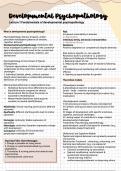Samenvatting
Samenvatting Lectures - Developmental Pyschopathology ()
De samenvatting biedt een overzichtelijke weergave van de hoorcolleges van het vak Developmental Psychopathology, waarin verschillende thema's behandeld worden. Het document behandelt zowel theoretische modellen (zoals psychodynamische, cognitieve en gedragsmodellen) als praktische onderwerpen, wa...
[Meer zien]




